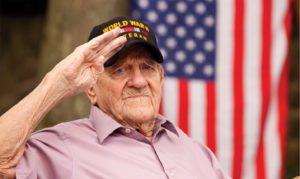By Michelangelo Mortellaro, P.A.
 According to Census Bureau numbers, there are approximately 10 million veterans who are 65 years old or older. Undoubtably, there are thousands of spouses of deceased veterans in this category as well. Various veterans assistance groups estimate close to 20 percent of these folks are likely eligible to receive tax-free money from the Department of Veterans Affairs through the Aid and Attendance benefit. Yet, one estimate said that in 2019 fewer than 500,000 were actually receiving this stipend each month.
According to Census Bureau numbers, there are approximately 10 million veterans who are 65 years old or older. Undoubtably, there are thousands of spouses of deceased veterans in this category as well. Various veterans assistance groups estimate close to 20 percent of these folks are likely eligible to receive tax-free money from the Department of Veterans Affairs through the Aid and Attendance benefit. Yet, one estimate said that in 2019 fewer than 500,000 were actually receiving this stipend each month.
The VA’s Aid and Attendance benefit remains one of the most underpublicized and least known benefits that could affect the lives of millions of American families. A&A provides monthly financial aid to help defray the cost of long-term care for those who need assistance with the daily activities of living such as dressing, bathing, toileting, eating and transferring. One of the important things to note is that this benefit does not require the veteran to have been injured or disabled during his or her military service.
So How Much?
What you really want to know right now is: How much will I get each month? The answer depends on who you are and how you document your financial situation.
In 2020, an unmarried veteran can receive a maximum allowable benefit of $1,911 each month. An unremarried surviving spouse’s maximum is $1,228. A veteran and spouse can get a maximum of $2,266 a month. We say “maximum” because there are income qualifications that could lower your benefit amount. Additionally, the benefit is adjusted annually for inflation.
Determining Your Eligibility
Applying for government benefits can be a daunting task, one that can seem difficult for even the most organized person when facing a blizzard of forms. But please know that with some document work early, and patience to the end, this benefit is obtainable. Let’s take a broad look at the process.
The first hurdle is checking eligibility under the VA’s guidelines. First, the veteran must meet requirements for age (65 or older) and service (minimum 90 consecutive days of active duty with at least one day during a recognized period of wartime, with a better-than-dishonorable discharge status).
Next, the veteran must show he needs assistance with at least two of the activities of daily living (bathing, toileting, dressing, eating, needs protective living environment, for example). This requires a form to be filled out by the claimant’s regular physician, and forms from an ALF or home caregiver, depending on circumstances.
Then there are income and asset guidelines. This is where the process gets murky for people and a VA-accredited attorney can help. The eligibility standards for surviving spouses varies a bit (marriage requirement), so visit the VA’s website or consult an attorney for details.
Homework
In addition to the physician forms mentioned above, the VA application entails multiple forms that serve specific purposes. The veteran application form differs from the one that a surviving spouse would use. Your situation will dictate which forms are necessary. Again, an attorney’s office can guide you.
Be prepared to gather statements from financial institutions (banks, investment accounts, IRAs, annuities, life insurance policies) and personal history documents (discharge papers, birth certificates, IDs, Social Security letters, marriage certificates, divorce decrees, among others).
Filling Out and Submitting the Application
Sitting down to fill out the various forms is time-consuming, and sometimes confusing. Put supporting documents and evidence with the appropriate forms, and fill in as many blanks as possible on each form. Put the VA form 21-4138 Support of Claim in front and make sure to sign and date in all the proper places.
Once you’re done, you can either mail the submission, fax it, or file it electronically through the VA’s website.
Next, be prepared to wait. The VA will acknowledge the claim has been received, then it may be quite some time before you hear from them again. You may receive a “development letter” if the VA requires additional information or documentation. Don’t worry, all of this is a normal part of the process, and you have up to one year to respond to the VA and submit the information requested. Or, you may receive a denial letter listing the reasons the application was denied. From there you can appeal the VA decision and submit evidence for the VA to reconsider.
And finally, when approved, you will receive a check (well, actually direct deposit to your bank account) retroactive to the month after your eligibility, then you will receive monthly deposits thereafter.
At Mortellaro Law, we have assisted veterans and their families with the VA Aid and Attendance process for more than 10 years. Call us for a free initial consultation to see if you are eligible for this important benefit.
And if you are a veteran, thank you for your service to our country.
The Law Office of
Michelangelo Mortellaro, P.A.
13528 Prestige Place, Suite 106
Tampa, FL 33635
813-367-1500
mortellarolaw.com
 Central Florida Health and Wellness Magazine Health and Wellness Articles of the Villages
Central Florida Health and Wellness Magazine Health and Wellness Articles of the Villages


